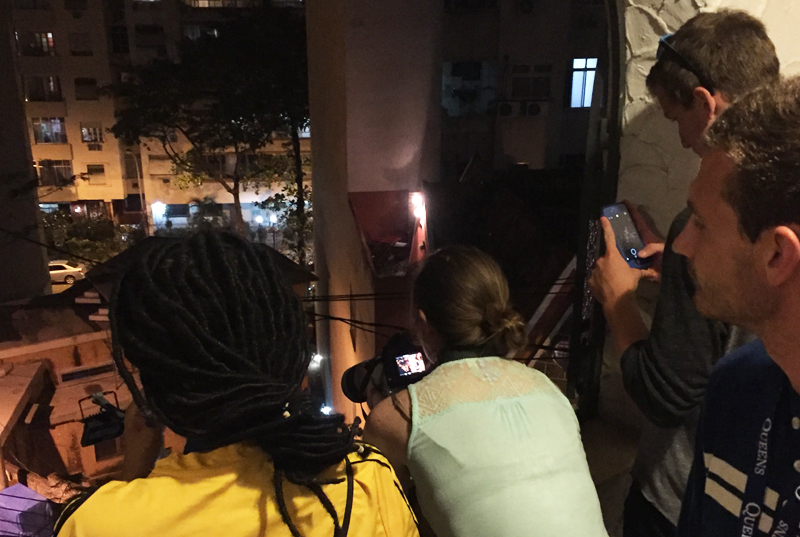
If you’ve been following us on social media, it is easy to assume it has been non-stop fun down here in Rio. However, since you’re looking at the queensinrio.org website, you know how hard we are working to cover stories surrounding the Games, all the while trying to stay safe in the process.
August 9th was a day of firsts for me. It was my team’s first day filming on the streets of Rio. It was my first time heading into the center of the Rio de Janeiro. And it was my first time hearing what it sounds like for security forces to disperse a crowd using tear gas and rubber bullets.
If you’ve never heard a tear gas can being launched, it sounds a lot like one loud single crack, almost as if someone has taken a tree branch and snapped it in one try. A few seconds later, we heard the sound of rubber bullets being fired. Those, as you can imagine, sound nearly identical to the real thing.
We were a block away and about four stories up. We had just finished interviewing two of the tourism analysts who helped prepare the original bid for the city of Rio de Janeiro to host the 2016 Olympic Games. We were at a hostel in Copacabana, considered one of the safer parts of the city. My team and I were packing up the video equipment when we heard the crack of tear gas and the rapid fire of rubber bullets.
As a journalist, your initial reaction would probably be to obtain the most information possible before heading down to the scene and putting yourself in what could be a dangerous situation. However, my immediate reaction was that I wanted to go down and get a closer look and try to find out what was happening on my own.
We, as the younger side of the millennial generation (age range of 15 to 24) are known for seeking instant gratification. We can attribute part of this to the integral role smart phones and social media play in our lives.
Since the demand for consuming information quickly and rapidly is so high, we have seen news sources embrace the trend and create accounts on platforms such as Facebook, Twitter, Snapchat, and Instagram.
The need to consume information instantly doesn’t just stop with news sources. Snapchats and text messages have replaced what used to be letters and phone calls. We now turn to the social media accounts of friends and family to keep in touch and to experience secondhand, what they are experiencing firsthand.
So, as my teammates and the residents of the hostel looked out over the edge of a balcony trying to watch what was unfolding a block away, I switched gears from the mindset of a journalist to that of a stereotypical millennial. I whipped out my phone and quickly relayed the message of what I was experiencing to friends and family back home via snapchat.
I later learned that the reason for the protest was the sale of illegal merchandise. After the security personnel sent the people selling the merchandise away from the beach, protesters began to throw rocks at cars as well as throwing the barricades into the street. That sparked the riot security personnel into action.
My colleagues told me later that I seemed to be conveying fear to my family and friends. Looking back, my concern was mostly about how this is daily reality for these people year-round, not just during the Olympics. For me, it was just a one-off experience.

